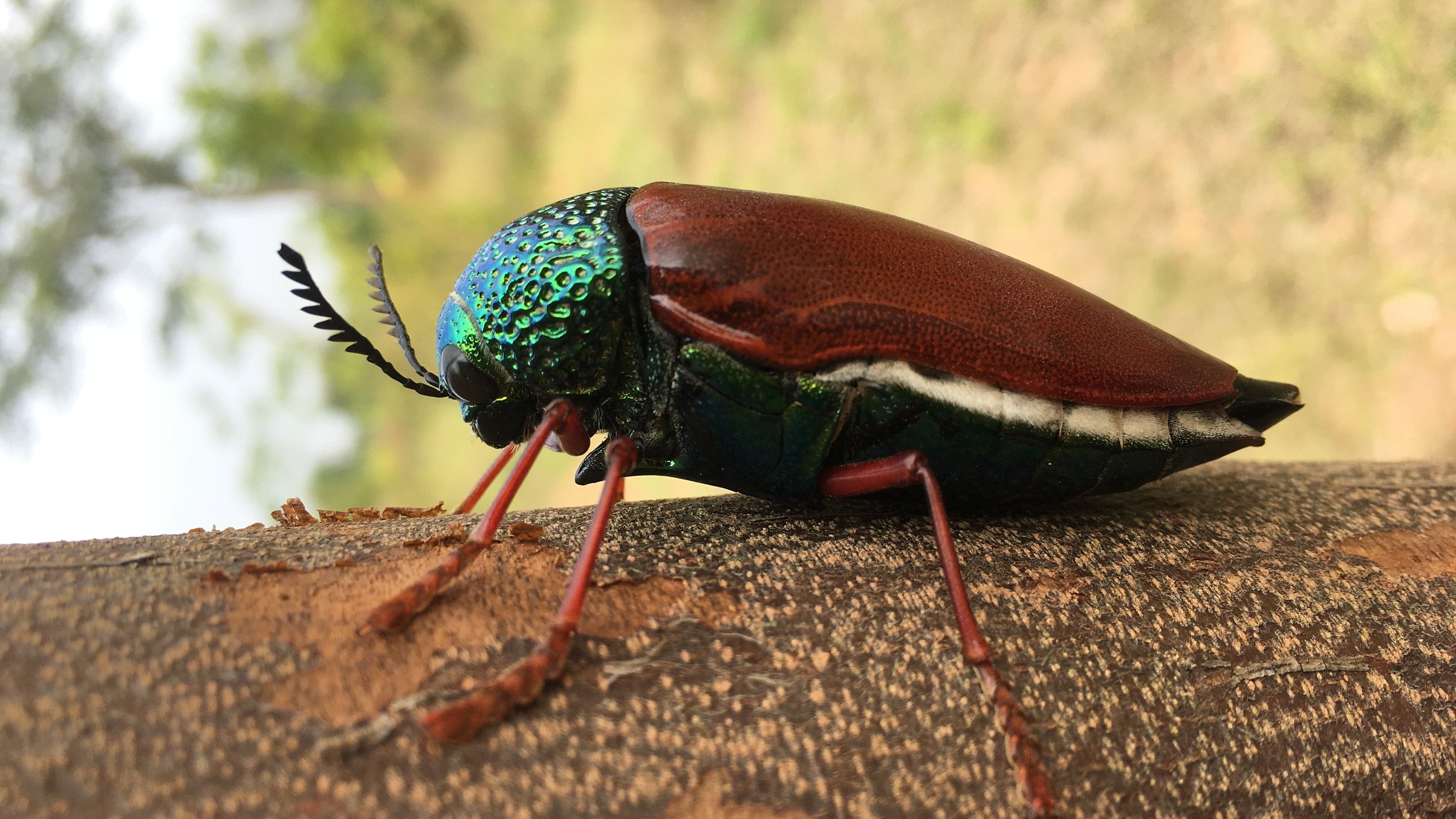
Jewel beetle.
Credit: Author
On a bright morning, a flash of green and russet glinted off a bare pole supporting our puny Scarlet Clock vine at Navilu Kaadu. Closer inspection revealed a large, oblong beetle, about an inch-and-a-half long, resting on the pole.
A glittering emerald thorax crowned a pair of bronze elytra — hardened forewings made from chitin that sheath the membranous hindwings, which get the beetle airborne. Feathery black serrate antennae adorned the small head at the tip of the glossy thorax.
‘This belongs on a Christmas tree,’ I thought. And it must’ve struck the folks too who named it when they called it the jewel beetle.
Jewel beetles belong to Buprestidae, among the largest beetle families with over 15,500 known species. Cultures worldwide have coveted the cerulean, amaranthine, and teal elytra of the jewel beetle in religion and adornment.
Indian researchers have found 100-year-old ornamental tassels bequeathed from mother to daughter over five generations, in the Rajasthan countryside, made from metallic-green thoraxes of what they call Bhingori — Sternocera chrysis — the exact specimen of jewel beetle that lives on Navilu Kaadu. Closer home in Karnataka, jewel beetles go by the moniker Jeerjimbe.
It seems counter-intuitive that a creature should draw perilous attention to itself this way.
Nifty couture on any creature serves specific functions — seducing winsome females, as in the jewel-toned male purple sunbird and the peacock with its resplendent plumage; warning off territorial contenders and drawing lady lizards, like in the male fan-throated lizard with its rainbow-hued dewlap; the bright ochre on the deadly poison dart frog signalling lethal fallouts, if handled. Jewel beetles are monomorphic — the male and the female of the species are alike and level up in embellishments, so seduction by iridescence is ruled out. Why then are these beetles kitted out for the disco? Don’t the jewel tones make them easy morsels for birds?
A century earlier, artist and naturalist Abbott Handerson Thayer propounded a contentious theory that biological iridescence in some species including jewel beetles, served to camouflage. Without empirical evidence to validate the theory, scientists of his time turned their noses down at Thayer’s hypothesis that such brilliant, metallic sheen helped conceal creatures from predators. In 2020, 100 years after Thayer was called cuckoo for attributing biological iridescence to disguise, scientists at the University of Bristol uncovered evidence that proved his hypothesis. We see colour when pigments on surfaces reflect certain wavelengths of the light spectrum and absorb some others. The reflected colour makes for easy identification of an object.
Iridescence, on the other hand, occurs when light bounces off nanostructures that are arranged in certain patterns on the surface tissue — in this case, a jewel beetle’s thorax and elytra. The nanostructures on the surface tissue radiate vibrant chromatic hues with changing light and viewing angle, akin to a tiny discotheque. This blurs the beetle’s form and effectively throws visual predators such as birds off their trail. The scientists at the University of Bristol placed mealworms in over 850 jewel beetle wing specimens, including iridescent jewel beetle elytra, identical wing models painted with non-iridescent nail varnish in green, purple, blue and black, and a wing set they called ‘static rainbow’ with all the colours of the iridescent elytra, but without the angular change.
The solid colours they chose matched peak wavelengths reflected by the iridescent elytra. The scientists placed them all on leaves in a forested patch for birds to find them. At the end of the period, more of the iridescent specimens were found intact.
Did the iridescence on the beetles’ wings truly distort and muddle the birds’ visual perception? Or was it aposematism, where the birds spotted the iridescent elytra, but perceived the shimmer as a warning signal to stay clear, like with the poison dart frog referenced earlier?
To determine this, scientists then sent human volunteers on the trail of these beetle wings. The findings were similar to the experiment with birds, lending solid credence to Abbott Thayer’s 100-year-old hypothesis that biological iridescence allowed creatures to “appear ‘dissolved’ into many depths and distances,” and was clearly “one of the prime factors of disguise.” Who would’ve thought brilliant iridescence is actually a camouflage trick!
Rooting For Nature is a monthly column on an off-kilter urban family’s trysts with nature on a natural farm.
The author chipped away at a software marketing career before shifting gears to sustainable entrepreneurship and natural farming. She blogs at www.bluejaydiaries.com and posts as @ramyacoushik on Instagram.